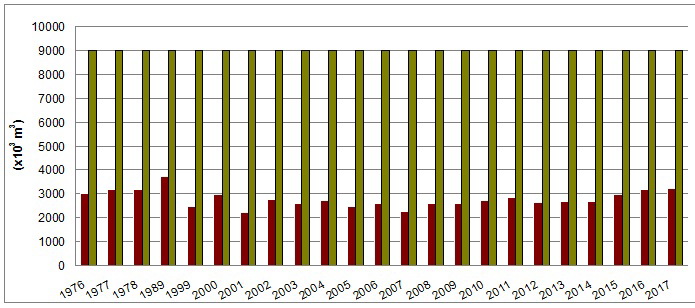Key message: Harvesting of wood is about 1/3 of increments
Assessment: The indicator measures sustainability of timber production as a potential for future availability of timber and wood cutting in forests. Wood cutting is the most important indicator of forestry as a commercial sector, but at the same time, an indicator of anthropogenic pressure. Timber volume in forests of the Republic of Serbia amounts to 363 million m3, which is around 161 m3/ha. In broadleaved forests, the volume was around 159 m3/ha, while in coniferous forests, the volume was around 189 m3/ha. Annual increment was around 9 million m3, or else around 4 m3/ha. Annual increment in broadleaved forests was around 3.7 m3/ha, while it was around 7.5 m3/ha in coniferous forests. Depending on the productivity of a species, its age distribution and species diversity, as well as on the type of ownership, annual increment considerably varies. Around 2,954,000 m3 of wood was logged in the forests of the Republic of Serbia in 2015, with was about 10% more than the previous year. During recent years, wood logging has increased by around 100,000 m3 per year, but it was still less intensive than in 2000. Analysis of the trend of wood cutting in the last 30 years has shown that over the last 30 years or so wood cutting ranged from 2,500,000 to 2,800,000 m3, which is less intensive than it was in 70s and 80s of the last century. Unofficial expert estimates were somewhat lower than the official data – around 3,000,000 m3 per year.

Indicator Name: Increment and wood cutting
Institution/Author: Environmental Protection Agency/Slaviša Popović
Use and interpretation:
The indicator measures sustainability of timber production as a potential for future availability of timber and wood cutting in forests.
Key question(s) which indicator helps to answer
The indicator helps to answer the question: How big is anthropogenic pressure which arises due to wood cutting?
Use of indicator
Timber volume in the forests of the Republic of Serbia amounts to 363 million m3, which is around 161 m3/ha. Wood cutting is the most important indicator of forestry as a commercial sector, but at the same time an indicator of the anthropogenic pressure.
Scale of appropriate use
Depending on the productivity of a species, its age distribution and species diversity, as well as on the type of ownership, annual increment varies considerably.
Potential for aggregation:
Meaning of upward or downward trends („good or bad“)
In broadleaved forests, the volume was around 159 m3/ha, while in coniferous forests, the volume was around 189 m3/ha. The annual increment was around 9 million m3, or else around 4 m3/ha. The annual increment in broadleaved forests was around 3.7 m3/ha, while in coniferous forests, it was around 7.5 m3/ha.
The amount of timber being cut was one-third of annual increment of timber volume of the forests. The ratio of annual increment (around 9,000,000 m3) to annual wood cutting (2,600,000 m3) is less than 3:1. According to the least favourable data, the ratio of annual increment to cutting is 3:2. Such a ratio may be considered satisfactory, both from the point of view of forest volume that will remain, and from the point of view of the quality of forest ecosystems.
Possible reasons for upward or downward trends:
Around 2,954,000 m3 of wood was logged in the forests of the Republic of Serbia in 2015, which was about 10% more than the previous year. In more recent years, wood logging has increased by around 100,000 m3 per year, but still less intensive than in 2000. Analysis of the trend of wood cutting in the last 30 years has shown that over the last 30 years or so wood cutting ranged from 2,500,000 to 2,800,000 m3, which is less intensive than it was in 70s and 80s of the last century. Unofficial expert estimates were somewhat lower than the official data – around 3,000,000 m3 per year. According to the data of the FAO/TCP/YUG/3201 project from 2011, as well as the UNECE report, the total amount of the logged timber in Serbia in 2012 was 6,099 million m3 (including wood cutting outside forests amounting to 1,441 million m3).
Implications for biodiversity management of change in the indicator:
The indicator is traditionally described in the annual state of the environment reports in Serbia, and it is determined as biodiversity indicator, according to the Rulebook on the National list of environmental protection indicators (Official Gazette of the Republic of Serbia No. 37/2011).
Units in which it is expressed:
The indicator is expressed in m3.
Description of source data:
Republic Statistical Office
Calculation procedure:
The methodology defined by criteria UNECE / FAO. The methodology is defined by the Statistical Office.
Most effective forms of presentation:
(graph types, maps, narratives, etc.-give examples where possible):
The best ways to present this indicator is graph.
Limits to usefulness and accuracy:
Given that the increment as the indicator is determined on the basis of the National Inventory Forest data, the limiting factor is the period between the implementation of two national inventory forests that should be every ten years, however, the period is higher.
The annual harvesting of forests is obtained by the complete coverage of the reporting units of the Statistical Office. The accuracy of the data can be assessed as satisfactory. The precision depends exclusively on delivery of data from all forest users.
Updating the indicator:
Statistical data are updated annually.
Closely related indicators
Forest management
Additional information and comments
Serbia